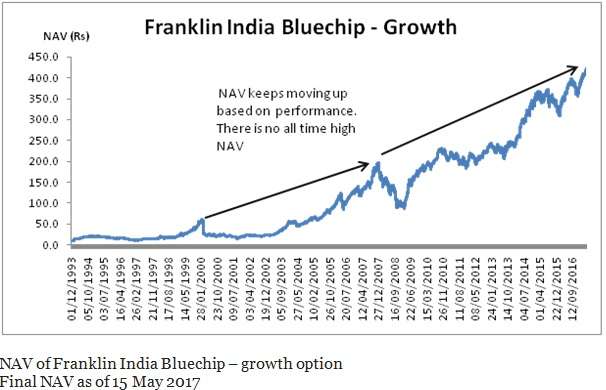Several investors buy funds because the NAV is ‘cheap’. They are also wary of buying a fund that has a ‘high’ NAV as it may not go up much. Like a stock, a fund cannot be judged based on its NAV. This is because NAV is not really a price of a fund. It is the value of all the underlying instruments it holds at any point in time. These instruments keep changing and hence there is no ‘fair value’ NAV for any fund. Let us discuss more to understand why high NAVs don’t really matter if the fund has potential to perform.
What is NAV
Let us first understand what a NAV is. The net asset value or NAV of a fund is the composite value of all the holdings of a fund expressed per unit of that scheme. It is the price at which you buy a single unit of the fund. NAV of a fund is arrived at by calculating the (Total assets of the fund – fund liabilities – expenses)/total number of units. As the total assets in the fund rise due to the increase in the value of the underlying securities(stocks, bonds etc), the NAV of the fund goes up. The converse is also true.
Any inflow and redemption will also affect the total assets in the fund, but that will be proportionally offset by the change in the number of units as units increase when more people invest and units decline when people redeem.
How NAV is not the same as stock price
NAV of a fund is not comparable to that of a stock price simply because the price of a stock is decided by the market based on the current and forecasted fundamentals of the company and its business. The NAV of a fund, on the other hand, is the aggregated price of the underlying stocks orbonds in the fund.
NAV is a value calculated everyday based on the end of day prices of the underlying instruments. Stock prices on the other hand, are driven by expectations, sentiment and change constantly based on the interest shown by the market in the stock. Such changes, at the end of the day are captured in a NAV. Since a fund by itself does not have a business and fair value, one cannot say that a fund is overvalued or undervalued. Based on the stocks it holds, it derives its own potential to perform. And remember the stocks are subject to change, based on whether the fund manager sees upside in the stock or not.
Why different funds have different NAVs
Different funds have different NAVs based on their time in existence and their performance. Here we are talking of ‘growth options and not ‘dividend’ options (as the latter distributes profits by way of dividend).
A fund’s life and how it has performed over the years determines the level of NAV of a fund. If a fund has had a longer life and also delivered good performance it’s NAV will seem high.
For example, we can notice that a HDFC growth fund and Principal growth fund that were launched in the year 2000 are currently at different levels of NAVs atRs 166 and Rs 127 (as of 15 May 2017). This difference can be attributed to HDFC delivering better returns and performing better than the Principal fund.
Why high NAV cannot be an indicator for exiting
A fund NAV is on an upward moving trajectory with no price ‘resistance’ or ‘support’ like a stock; if it performs well and unearths stocks/instruments with ability to deliver returns. There will be intermediate blips in prices as and when markets fall. When markets move up steeply, fund NAV too will appreciate to newer levels. Just take a look at the graph below of Franklin India Bluechip. If you had not invested in the fund because it touched ‘new highs’ you would simply have lost opportunities to make money in the long term.

A stock may have to be trimmed when it rallies and goes beyond its fair price but the same may not hold good for a fund that has hit an all-time high NAV. This is because the fund manager has the option of always exiting such stocks in his/her portfolio and enter another stock that offers greater value and greater appreciation potential. And this keeps happening all the time for all the stocks in the fund.
Therefore, a high NAV of a fund cannot be an indicator for exiting the fund.







